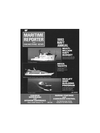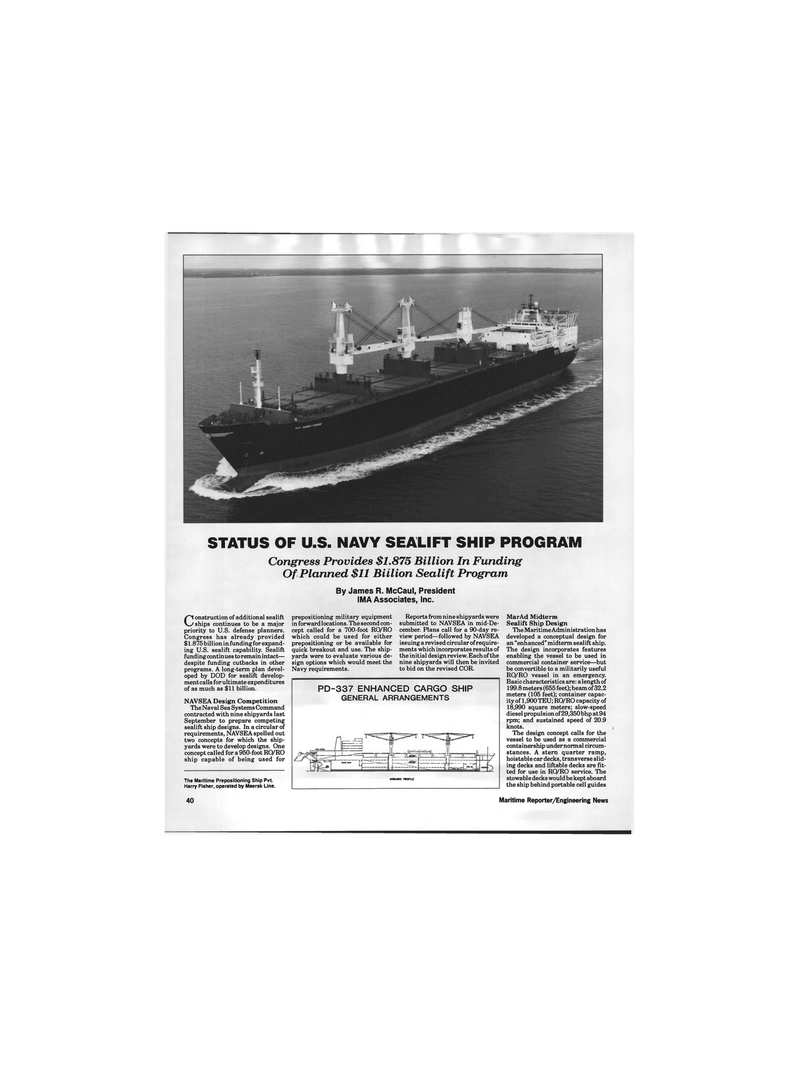
Page 40: of Maritime Reporter Magazine (February 1992)
Read this page in Pdf, Flash or Html5 edition of February 1992 Maritime Reporter Magazine
STATUS OF U.S. NAVY SEALIFT SHIP PROGRAM
Congress Provides $1,875 Billion In Funding
Of Planned $11 Billion Sealift Program
By James R. McCaul, President
IMA Associates, Inc.
Construction of additional sealift ships continues to be a major priority to U.S. defense planners.
Congress has already provided $1.875 billion in funding for expand- ing U.S. sealift capability. Sealift funding continues to remain intact— despite funding cutbacks in other programs. A long-term plan devel- oped by DOD for sealift develop- ment calls for ultimate expenditures of as much as $11 billion.
NAVSEA Design Competition
The Naval Sea Systems Command contracted with nine shipyards last
September to prepare competing sealift ship designs. In a circular of requirements, NAVSEA spelled out two concepts for which the ship- yards were to develop designs. One concept called for a 950-foot RO/RO ship capable of being used for
The Maritime Prepositioning Ship Pvt.
Harry Fisher, operated by Maersk Line. prepositioning military equipment in forward locations. The second con- cept called for a 700-foot RO/RO which could be used for either prepositioning or be available for quick breakout and use. The ship- yards were to evaluate various de- sign options which would meet the
Navy requirements.
Reports from nine shipyards were submitted to NAVSEA in mid-De- cember. Plans call for a 90-day re- view period—followed by NAVSEA issuing a revised circular of require- ments which incorporates results of the initial design review. Each of the nine shipyards will then be invited to bid on the revised COR.
PD-337 ENHANCED CARGO SHIP
GENERAL ARRANGEMENTS
INBOARD PROFll£
MarAd Midterm
Sealift Ship Design
The Maritime Administration has developed a conceptual design for an "enhanced" midterm sealift ship.
The design incorporates features enabling the vessel to be used in commercial container service—but be convertible to a militarily useful
RO/RO vessel in an emergency.
Basic characteristics are: a length of 199.8 meters (655 feet); beam of 32.2 meters (105 feet); container capac- ity of 1,900 TEU; RO/RO capacity of 18,990 square meters; slow-speed diesel propulsion of29,350 bhp at 94 rpm; and sustained speed of 20.9 knots.
The design concept calls for the vessel to be used as a commercial container ship under normal circum- stances. A stern quarter ramp, hoistable car decks, transverse slid- ing decks and liftable decks are fit- ted for use in RO/RO service. The stowable decks would be kept aboard the ship behind portable cell guides 40 Maritime Reporter/Engineering News

 39
39

 41
41
